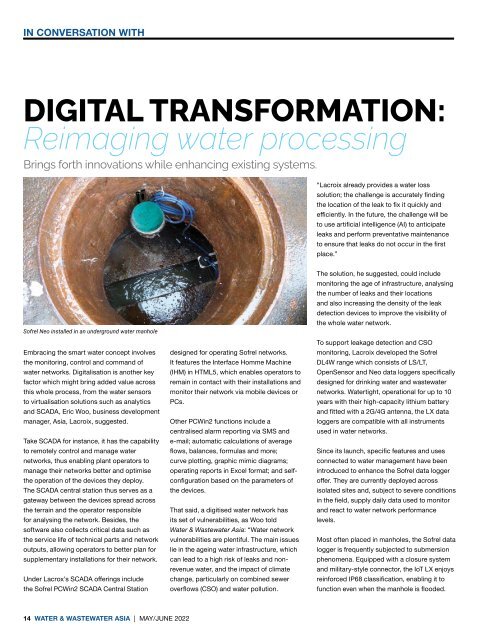Water & Wastewater Asia May/June 2022
Water & Wastewater Asia is an expert source of industry information, cementing its position as an indispensable tool for trade professionals in the water and wastewater industry. As the most reliable publication in the region, industry experts turn this premium journal for credible journalism and exclusive insight provided by fellow industry professionals. Water & Wastewater Asia incorporates the official newsletter of the Singapore Water Association (SWA).
Water & Wastewater Asia is an expert source of industry information, cementing its position as an indispensable tool for trade professionals in the water and wastewater industry. As the most reliable publication in the region, industry experts turn this premium journal for credible journalism and exclusive insight provided by fellow industry professionals. Water & Wastewater Asia incorporates the official newsletter of the Singapore Water Association (SWA).
Create successful ePaper yourself
Turn your PDF publications into a flip-book with our unique Google optimized e-Paper software.
IN CONVERSATION WITH<br />
DIGITAL TRANSFORMATION:<br />
Reimaging water processing<br />
Brings forth innovations while enhancing existing systems.<br />
“Lacroix already provides a water loss<br />
solution; the challenge is accurately finding<br />
the location of the leak to fix it quickly and<br />
efficiently. In the future, the challenge will be<br />
to use artificial intelligence (AI) to anticipate<br />
leaks and perform preventative maintenance<br />
to ensure that leaks do not occur in the first<br />
place.”<br />
Sofrel Neo installed in an underground water manhole<br />
Embracing the smart water concept involves<br />
the monitoring, control and command of<br />
water networks. Digitalisation is another key<br />
factor which might bring added value across<br />
this whole process, from the water sensors<br />
to virtualisation solutions such as analytics<br />
and SCADA, Eric Woo, business development<br />
manager, <strong>Asia</strong>, Lacroix, suggested.<br />
Take SCADA for instance, it has the capability<br />
to remotely control and manage water<br />
networks, thus enabling plant operators to<br />
manage their networks better and optimise<br />
the operation of the devices they deploy.<br />
The SCADA central station thus serves as a<br />
gateway between the devices spread across<br />
the terrain and the operator responsible<br />
for analysing the network. Besides, the<br />
software also collects critical data such as<br />
the service life of technical parts and network<br />
outputs, allowing operators to better plan for<br />
supplementary installations for their network.<br />
Under Lacrox’s SCADA offerings include<br />
the Sofrel PCWin2 SCADA Central Station<br />
designed for operating Sofrel networks.<br />
It features the Interface Homme Machine<br />
(IHM) in HTML5, which enables operators to<br />
remain in contact with their installations and<br />
monitor their network via mobile devices or<br />
PCs.<br />
Other PCWin2 functions include a<br />
centralised alarm reporting via SMS and<br />
e-mail; automatic calculations of average<br />
flows, balances, formulas and more;<br />
curve plotting, graphic mimic diagrams;<br />
operating reports in Excel format; and selfconfiguration<br />
based on the parameters of<br />
the devices.<br />
That said, a digitised water network has<br />
its set of vulnerabilities, as Woo told<br />
<strong>Water</strong> & <strong>Wastewater</strong> <strong>Asia</strong>: “<strong>Water</strong> network<br />
vulnerabilities are plentiful. The main issues<br />
lie in the ageing water infrastructure, which<br />
can lead to a high risk of leaks and nonrevenue<br />
water, and the impact of climate<br />
change, particularly on combined sewer<br />
overflows (CSO) and water pollution.<br />
The solution, he suggested, could include<br />
monitoring the age of infrastructure, analysing<br />
the number of leaks and their locations<br />
and also increasing the density of the leak<br />
detection devices to improve the visibility of<br />
the whole water network.<br />
To support leakage detection and CSO<br />
monitoring, Lacroix developed the Sofrel<br />
DL4W range which consists of LS/LT,<br />
OpenSensor and Neo data loggers specifically<br />
designed for drinking water and wastewater<br />
networks. <strong>Water</strong>tight, operational for up to 10<br />
years with their high-capacity lithium battery<br />
and fitted with a 2G/4G antenna, the LX data<br />
loggers are compatible with all instruments<br />
used in water networks.<br />
Since its launch, specific features and uses<br />
connected to water management have been<br />
introduced to enhance the Sofrel data logger<br />
offer. They are currently deployed across<br />
isolated sites and, subject to severe conditions<br />
in the field, supply daily data used to monitor<br />
and react to water network performance<br />
levels.<br />
Most often placed in manholes, the Sofrel data<br />
logger is frequently subjected to submersion<br />
phenomena. Equipped with a closure system<br />
and military-style connector, the IoT LX enjoys<br />
reinforced IP68 classification, enabling it to<br />
function even when the manhole is flooded.<br />
14 WATER & WASTEWATER ASIA | MAY/JUNE <strong>2022</strong>


















